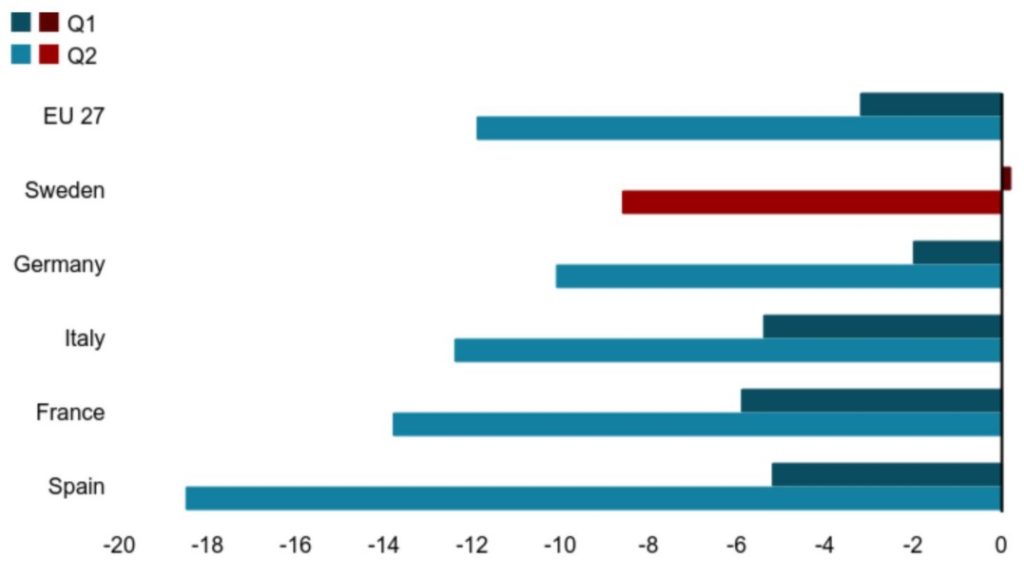The Swedish way
Introduction
Most countries have applied lockdown rules, imposing movement only if absolutely necessary, for shopping, essential workers and exercising. This has had positive results, slowing the spread of the virus and avoiding medical infrastructure oversaturation.
The way Sweden handled the pandemic in the first wave resulted in a big controversy. Sweden’s state epidemiologist Anders Tegnell chose to go for sustainable measures on the long run viability, of the strategy, if the coronavirus remains a threat for long periods of time. Lockdown measures may function on the short term but are less sustainable on the long run, was his thought process. Herd immunity, which was never a main goal of this strategy, is achieved by infecting a large part of the population (50-90%), making it difficult for the virus to survive and propagate in bodies which produce antibodies to deal with the virus. This strategy implies the sacrifice of the most vulnerable in higher numbers than in a conventional lockdown. Masks were seen only rarely and restaurants, bars and nightclubs stayed open. Schools for pupils above 16 were closed and contact with vulnerable people was not suggested. The way Sweden was countering the virus was unbelievable, raising many criticisms from other countries. The government tried giving easy measures to contain the spread of the virus, and the population seemed to follow the guidelines, showing good will. But not everyone felt concerned : Sweden’s death toll was higher than all the Scandinavian countries united, and cases higher than any Scandinavian country. With a second wave starting and cases continuing to rise, Sweden has started to take tougher measures to combat the pandemic whilst still not resorting to lockdown, which seems to raise the question; was the strategy successful during the first wave?

Medical situation
From a medical point of view, herd immunity, which was one of the potential positive sides to this strategy, has still not been reached. In late April, a study on the population of Stockholm, the most heavily hit city in the country, found that only 7-10% of habitants had developed antibodies. Furthermore, a high mortality and number of infections occurred, a majority of which affected the elderly, with 50% of deaths happening in care homes. Reports of care workers working long shifts with little protective equipment, and sometimes continuing working whilst displaying symptoms is one of many factors responsible for the high death toll. Privatisation of the healthcare service and bad medical preparation were also to blame; a lack of medical assistance was often the case and municipalities did not have enough funds to give those dying people a chance to live. The number of people in respiratory care were lower than a year before when no coronavirus was present. Furthermore, testing was only being kept for healthcare workers and people in need of hospitalization, lowering the number of detected covid cases. Contact tracing was abandoned and quarantaine in a household with an infected person was not recommended.
“Older people are routinely being given morphine and midazolam,
which are respiratory-inhibiting. It’s active euthanasia, to say the least.”
(Yngve Gustafsson, professor of geriatric medicine)
Economy
Even though this strategy did not consider economy as a main objective, there was hope that no-lockdown rules would mitigate the effects of the pandemic on economy through less job losses and keeping businnesses up and running. Sweden’s economy is dependant on international markets and trade, because theyre export market is proeminant, particularly to Europe and the UK. This means that Sweden’s economy will also be heavily impacted by the European and Worldwide trade and economy status. Sweden’s unemployment rate rose from 7,1 to 9% between March and April and predictions are that the Gross Domestic Produce will have decreased by approximately 4,5 % by the end of the year. Despite fairing better than other European countries, Sweden’s economy is also being affected by the crisis. Cell phone data indicates that people in Sweden are moving less than they used to, and salesworkers are seeing a distinct difference in clientele presence. With some shops offering big discounts to make ends meet and some closed, the crisis is very difficult to avoid, even in a country where the country is not paralyzed by lockdown.

Public Opinion
During the first wave, most people were happy with the lack of measures, seeing it as confidence in the population to act responsibly. Sweden is a generally trusting country towards experts. Compared to other countries, non-governmental advice and expertise is more present in decision-making by the government. Sweden communicated messages that were contradictory, and was more advice than strict rules. Instructions to avoid public areas whilst businnesses were still open contributed to confuse the public. As the death toll rose, there was less confidence in the government. A poll shows that in March, only 45% of Swedes believed that the government is able to handle the crisis compared to 63% in April. In August, it dropped to 34%. The support for the Swedish Health Organization has declined but has remained strong. The situation has divided Sweden, and trust in the government was getting lower.
References
Websites : BBC, Forbes, Politico, WordPress
Articles : Habib, H. (2020). Has Sweden’s controversial covid-19 strategy been successful? BMJ, 369. https://doi.org/10.1136/bmj.m2376
Featured image : spectator.us




